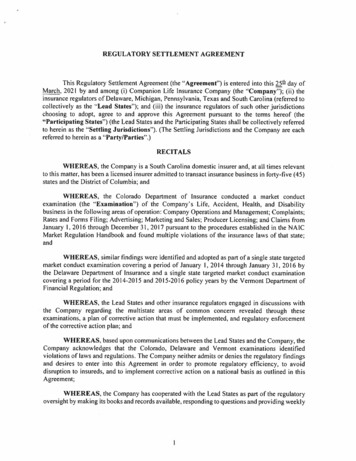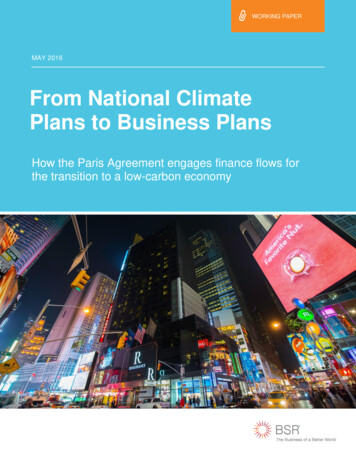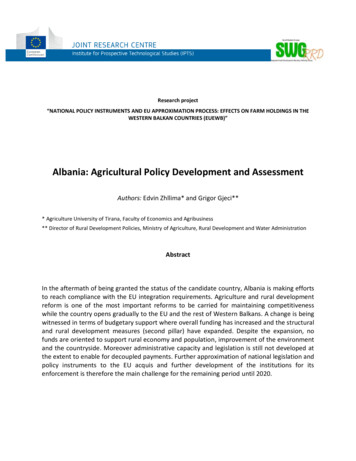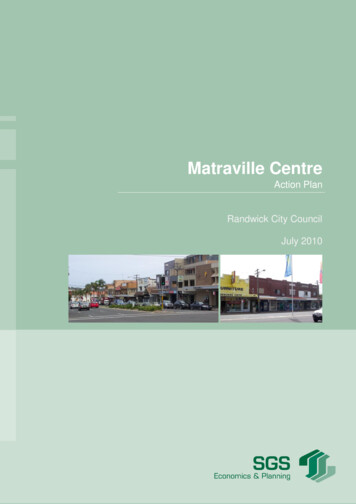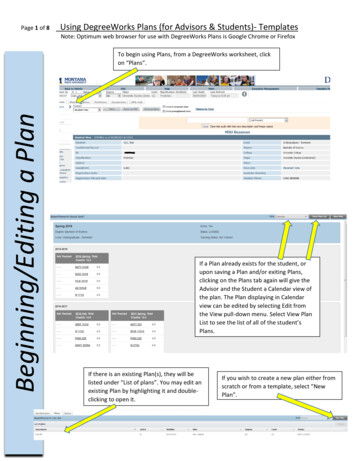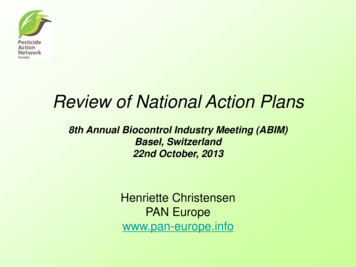
Transcription
Review of National Action Plans8th Annual Biocontrol Industry Meeting (ABIM)Basel, Switzerland22nd October, 2013Henriette ChristensenPAN Europewww.pan-europe.info
Presentation Outline Who is PAN EuropeThe legal framework: Directive 128/2009 (SUD)First assessment of the National Action Plans (NAPs)Then what (and when)?What I will not talk about:IP as a system approach, I will instead only considerbiocontrol as isolated case, though PAN Europe believesin IP as a holistic approach starting with agronomy
Our challenge:Making sure things get moving
Who is PAN Europe PAN Europe is one of the 5 centers of PANInternational 32 not-for-profit members in 24 European countries Bring together health, environmental & womenassociations Working to replace use of hazardous pesticides withecologically sound alternatives Brussels based with 4 part time employeesSlogan fromthe PURE campaign:
Time tables for nationalimplementation of the SUDOverall implementation 26 November 2011 : MS to convert Directive 2009/128/EC intonational law (art. 23) 26 November 2012 : MS shall communicate NAP to Commissionand to other MS (art. 4.2)IPM implementation:30 June 2013 : MS shall communicate on how to implement IPM toCommission (art. 14.3)National evaluation: Member States shall review National Action Plans at least every fiveyears, meaning max November 2016 (art 4.2)
First assessment of available NAPs
Which MS are engaging?NAPs available in English (22):Austria, Bulgaria, Cyprus, Czech Republic, Denmark,Estonia, Finland, Germany, Greece, Hungarian, Ireland,Latvia, Lithuania, Malta, Netherlands (old version),Poland, Portugal, Slovakia, Slovenia, Spain, Sweden,United KingdomNAPs available in national language (2):France, RomaniaStill to come (4):Belgium, Italy, Luxembourg, Croatia
Facts on the SUDimplementationThe implementation of the NAPs range wide: Covers many EU laws Covers many national law, and Will depend on several ministries, agencies etcBut is a great opportunity to get an overview ofthe ‘pesticide picture’ in MS (baseline)The challenge is how to make sure MS takeactionor
Huge differences innational policies (baseline) Everybody had specific measures in place(training, check of equipment, sale) Many have problems to respect EU law(WFD, MRLs) Some have certain schemes in place(IPM), but only Few had overall reduction targetsand real plans (ex FR, DK)
Huge differences in how theNAPs are written 1 member states (DK) mentions only newmeasures; Majority of Member States give an overview of allthey do (to fulfil different pieces of EU legislation); Some MS (CZ) include a nice backgroundevaluation of environmental and public healthproblems One MS (AU) has regional AP rather than NAP For one MS (CY) archaelogical sits is a sensitiveareas for others it is greenhouses/recent treatedareas (Malta,
Quantitiative targetsin the NAPsOnly one with overall targets: DK: 40% reduction in use from 2011 to 2015;Few with part targets: CZ: 10% reduction in residues from domesticproduction from 2010 to 2020 LT: 2 % reduction in overall MRLs levels from 2010 to2017, and land use for organic to increase by up to2% in 2017, as compared to the average in 2008–2011LT: 5 new authorised biocontrol products as from2013
SUD on biocontrolArticleDescriptionArticle 1 –subjectmatterThis Directive establishes a framework to achieve a sustainable useof pesticides by reducing the risks and impacts of pesticide use onhuman health and the environment and promoting the use ofintegrated pest management and of alternative approaches ortechniques such as non-chemical alternatives to pesticides.Article 3 definition‘non-chemical methods’ means alternative methods to chemicalpesticides for plant protection and pest management, based onagronomic techniques such as those referred to in point 1 of AnnexIII, or physical, mechanical or biological pest control methodsArticle 12risks inspecificareasMember States shall (ensure) use of pesticides is minimised orprohibited in certain specific areas and biological controlmeasures shall be considered in the first place.(a) public parks and gardens, sports and recreation grounds, schoolgrounds and children’s playgrounds and in the close vicinity ofhealthcare facilities;(b) protected areas for water and for conservation (nature andwildlife)
SUD on biocontrolAnnexAnnex ITrainingAnnex IIIGeneralprinciplesof IPMDescriptionNotions on integrated pest management strategies andtechniques, integrated crop management strategies andtechniques, organic farming principles, biological pestcontrol methods, information on the general principles andcrop or sector-specific guidelines for integrated pestmanagement.Sustainable biological, physical and other non-chemicalmethods must be preferred to chemical methods if theyprovide satisfactory pest control.But how do Member States target biological control in their NAPs?
NAPs not engaging in biocontrol 2 MS does not mention biocontrol at all(Bulgaria, Portugal) 5 MS only mention biocontrol regardingsensitive areas (Greece, Malta, Cyprus,Ireland, Malta) Many take a ‘traditional approach’of more training, more researchand more trials, meaning it cantake years before IPM getsoperational.
Few depressing biocontrolstatement in the NAPs The range of such products has beenlimited to date. Therefore, it is necessaryto encourage research into theeffectiveness and practical applicationof biological products for plant protection(Latvia) There is mainly a need to encourage useof biocontrol in organic farming(Finland & Hungary)
Curious objectives onbiocontrol Poland prohibits the use of chemical andbiological pesticides and fertilisers insensitive areas Czech Republic has a beautiful analysis ofpesticide problems – mentioning both IOBCand IBMA – but biological control not proposedas part of actions Very specific monitoring: The proportion ofconifer saplings protected using nonchemical methods.(Sweden)
Interesting actions proposed(1) Reduce dependency: where possible, a significantproportion of chemicals to be replaced by nonchemical alternatives, among other biocontrol (Austria– no ‘where possible’ in NAPs of Carinthia/Vorarlberg) Centre for Biological Control: a new centrelaunched in 2012 focusing on controlling pests anddeseases with living organism. Meant to closelycollaborate with stakeholders (Sweden)
Interesting actions proposed (2) Involving biocontrol companies: by July 2013identify microbial containing living organism approvedin the northern zone and by Dec 2014 contact ownersasking them to apply (Latvia) Assisting biocontrol companies: financial andtechnical support to companies wishing to apply forautorisation of biocontrol products (Denmark) More products on the market: Research( 150,000/year), approval of 10 active substancessince 2006, and approved biopesticides is 1 of 7 coreindicators (UK).
Biocontrol as successindicator (1) Estonia: ‘Economic indicator ‘increase thepercentage of users who apply biological controlplant protection products and alternative pestmanagement techniques’ Germany: ‘Indicator no (13)’ indicating the extent towhich biological plant protection measures arebeing used. ‘Indicator no (27)’ indicating domesticissue of active substances for both chemicals andbiocontrol products. Lithuania: One of two ‘economic indicators’ is:Increase in the number of registered biologicalplant protection products (Baseline 2012)
Biocontrol as successindicator (2) Spain: Success indicators number ofdemonstrations and dissemination activitiesundertaken and the number of hectares ofagricultural land and woodland usingalternative pest control systems (masstrapping, sterile insect technique, biologicalcontrol or chemical sterilisation, etc.). UK: Cumulative numbers of activesubstances and products approved asbiopesticides, in any one year, by type and bytype and use.
Integrated pestmanagement, low inputand organic farming(build on already existing) BU, HU, MT,SI, UK to build on commercial IP labels toestablish sector specific guidelines, but will these beupdated as from 2014 and/or will new biocontrol products beincluded? AU, CY, CZ, EE, DE, HU, IT, LT, PO, SI, SL, ES offer publicIP support as part of rural development of the EU’s CommonAgricultural Policy rural development policy others (IT) aspart of Common Market Organisation for fruit and vegetables,but will measures be updated as from 2014, and/or will newbiocontrol products be included?
Examples of CAP supportCountry/RegionIT/Emilia RomagnaAustriaFranceBelgium (Flandre)Luxembourg,InstrumentWhatAmount /haF&V CMOuse of selected 100 (arable) 300pesticides combined with(vegetables), 550 (fruit)an integrated productionper hectaresystemAgro-envir. in RuralDevelopmentcrop rotations (annualcrops), restrictions onfertiliser and pesticideuse, training and recordkeepingAEbiological control agents,64 ; vegetables: 105 ,introduction offruit trees: 70 ; grapes:beneficiaries, sexual79 confusionAEsexual confusion againstthe codling moth inpipfruit (for at least 5years and on at least 1ha)AEbiological control agents 120 or 200 /hato fight Cochylis etdepending on the exactEudemia on grapesintervention needed 150/ha (potatoes andturnips), 250/ha(strawberries), 300/ha(fruit and hops), up to 400/ha (vines250
Critical points in ‘biocontrol inagriculture as part of SUD’ are:1. Too many MS are being prudent in introducing biocontrol, alternativesand IPM, allowing too many loopholes2. EU policy makers argues IPM is local, while almost impossible forregions to be updated on new biocontrol products, to have thetechnical skills etc3. CAP too focused on keeping status quo rather than focusing new nonchemical (innovative)- solutionsQuestions are:1. (When) will the CAP start focusing on sustainable forward looking solutions ensuring full IPM (combination ofag. practices and biocontrol)?2. Will the EU assess indicators on biocontrol, alternativesand IPM?
Some ideas on whatwe could do together1. Keep on organising joint events to draw attention toBC, IPM, and non chemicals next being the 5December symposium in European Parliament2. Call on the need for all NAPs to have specificindicators on BC, IPM and non chemical alternatives –more products, more users and more hectares - andclear timetable to be controlled by EU3. Mobilise farmers, advisers, researchers, alternativecompanies NGOs on the ground to start workingtogether on BC/IPM (operational groups)4. Establish a EU wide technical support centre on nonchemical alternatives
Time tables for EU action onimplementation of the SUDMonitoring and surveying health and environmentimpacts 26 November 2012 : Commission in collaboration withMS make guidance document on environment andhealth monitoring and surveillance (art 7.3)EU evaluation: 26 November 2014 : Commission submit report on NAPimplementation to EP and Council (art. 4.3) 26 November 2018 : Commission submit report on NAPimplementation to EP and Council. It may beaccompanied, if necessary, by appropriatelegislative proposals (art. 4.4)
Time to make the elephant move!
8th Annual Biocontrol Industry Meeting (ABIM) Basel, Switzerland 22nd October, 2013 Henriette Christensen PAN Europe www.pan-europe.info. Presentation Outline . Member States shall review National Action Plans at least every five years, meaning max November 2016 (art 4.2) First assessment of available NAPs.
